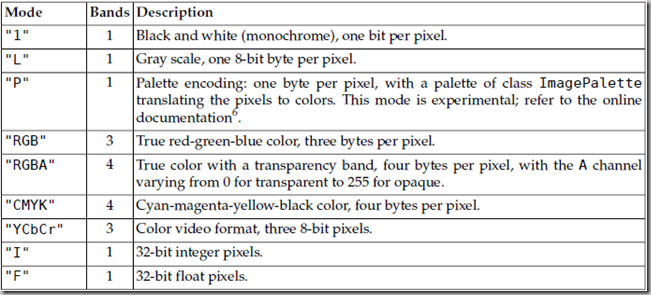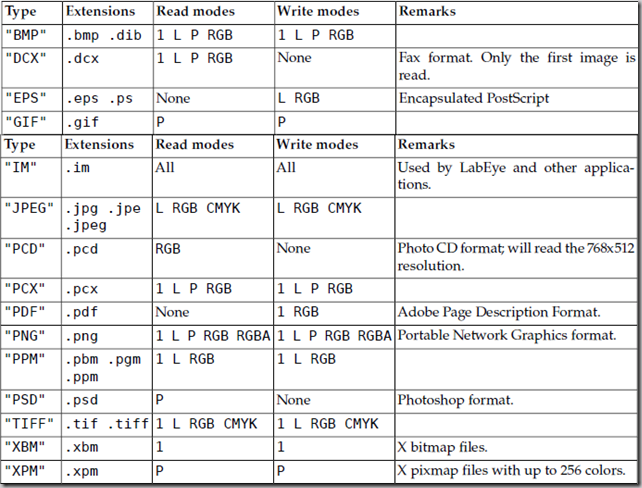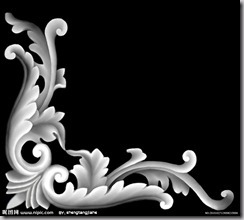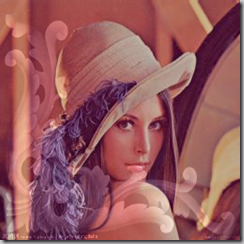Python图像处理库(PIL),,Python Ima
Python图像处理库(PIL),,Python Ima
Python Imaging Library为您的python程序添加图像处理能力。这个库提供广泛的文件格式支持、高效的内部表示和相当强大的图像处理能力。
核心图像库是为快速访问几种基本像素格式图像设计的。它能为一般的图像处理工具提供一个可靠的基础。
这个Pythonic library可以
装载和保存多种格式文件 Loading and Saving images(diverse formats)Python Imaging Library的最新版本可以识别并读取多数图像格式。写图像操作则有意地限制为最常用的交流和发布的格式。 convert images between different pixel representations 图像格式转换缩放、裁剪、合成、变换和通道 Scaling, cropping, compositing, transforms, bands(the separate color channels e.g. alpha channel 半透明通道)
The library also supports image resizing, rotation and arbitrary affine transforms.提供图像缩放,旋转和任意仿射变换的支持。图像增强Image Enhancement
point operations,filtering with a set of built-in convolution kernels, and colour space conversions. 像素操作,内置convolution kernel的滤镜和颜色空间变换
adjust contrast, brightness, colour balance and sharpness using the ImageEnhance module直方图、对比增强和统计分析 histogram,contrast enhancement,statistical analysis
There‘s a histogram method allowing you to pull some statistics out of an image. This can be used for automatic contrast enhancement, and for global statistical analysis.提供histogram方法使您可以输出对某个图像的一些统计信息。这可以用于自动对比增强和全局统计分析。绘制文字和基本图形 Drawing text and basic shapes图像序列(动画) Image Sequences
Supported sequence formats include FLI/FLC, GIF, and a few experimental formats. TIFF files can also contain more than one frame.
图像显示Image DisplayThe current release includes TkPhotoImageandBitmapImageinterfaces, as well as a Windows DIB interface that can be used withPythonWin. For X and Mac displays, you can use Jack Jansen‘simglibrary.最新发布版本包含Tk PhotoImage and BitmapImage 接口,Windows DIB 接口也可以随着PythonWin一起使用。而对了X 和Mac系统的显示,您可以使用Jack Jansen的图像库。
For debugging, there‘s also ashowmethod in the Unix version which calls xv to display the image. Debug版本中,于Unix也提供show方法调用xv来显示图像图像打印 Postscript Printing
print images, text and graphics on Postscript printers
几个应用的例子:
基本概念 PIL API - Concepts
尺寸Sizes
The size attribute is a 2-tuple containing width and height (in pixels).
通过图片对象的size属性可以得到图片的尺寸,结果这是一个二元组,包含水平和垂直方向上的像素数。
坐标Coordinates
The graphics interface uses the same coordinate system as PIL itself, with (0, 0) in the upper left corner.
Pil采取左上角为(0,0)的坐标系统
角度 Angles
Angles are given in degrees. Zero degrees is in the +x (east) direction, and the angle increases
counter-clockwise,in the usual Cartesian convention. For example, angle 45 points northeast.
边界框 Bboxes(Bounding boxes)
A bounding box or bbox is a rectangle(矩形) in the image. It is defined by a 4-tuple, (x0, y0, x1, y1) where (x0,y0) is the top left (northwest) corner of the rectangle, and (x1, y1) is the bottom right (southeast) corner.
Generally, the area described by a bounding box will include point (x0, y0), but it will not include point (x1, y1) or the row and column of pixels containing point (x1, y1).
For example, drawing an ellipse inside the bounding box (0,0,5,10) will produce an ellipse 5 pixels
wide and 10 pixels high. The resulting ellipse will include pixel column 4 but not column 5, and will
also include pixel row 9 but not row 10.
由四元组(x0, y0, x1, y1)定义的一个矩形区域。区域包括左上角(x0,y0),但不包括右下角(x1, y1)或者(x1, y1)所在行列的像素点。
通道 Bands– the separate color channels
An image band is a set of values, one per image pixel.
Monochrome(黑白) or grayscale images have one band;color images in the RGB system have three bands, CMYK images have four, and so on.
Photoshop users will recognize bands as similar to Photoshop channels.
一个图片可以包含一到多个数据通道,如果这些通道具有相同的维数和深度,Pil允许将这些通道进行叠加.
在RGB模式下,每个图片由三个通道叠加而成,每个模式下为一个灰度图,当有一个调色板来调色的时候,这三张灰度图的叠加即可合成3*8位(每个像素)的一个真彩图片。
pil库中,图片之间的模式(mode)可以转化。
>>> bands = im.split ()
>>> rIm = bands [0]
>>> aIm = bands [3]
>>> remadeImage = Image.merge (“RGBA”, (rIm, gIm, bIm, aIm))
>>> grayscaleIm = Image.open (“myAlpha.gif”)
>>> remadeImage = myImage.putalpha (grayscaleIm) # replace the alpha band
模式 Mode
the number and names of the bands in the image, and also the pixel type and depth.
Common modes are "L" (luminance) for greyscale images, "RGB" for true colour images, and "CMYK" for pre-press images.

1(1-bit pixels, black and white, stored with one pixel per byte)
1位像素,黑和白,存成8位的像素
L(8-bit pixels, black and white)
8位像素,黑白
P(8-bit pixels, mapped to any other mode using a colour palette)
8位像素,使用调色板映射到任何其他模式
RGB(3x8-bit pixels, true colour)
3×8位像素,真彩
RGBA(4x8-bit pixels, true colour with transparency mask)
4×8位像素,真彩+透明通道
CMYK(4x8-bit pixels, colour separation)
4×8位像素,颜色隔离
YCbCr(3x8-bit pixels, colour video format)
3×8位像素,彩色视频格式
I(32-bit integer pixels)
32位整型像素
F(32-bit floating point pixels)
32位浮点型像素
调色板 Palette
mode("P")为每个像素定义具体的颜色值
颜色 Color– 32位数值、元组或字符串 specified as 32bit value, tuple, or string
单通道图像-像素数值32bit value
For single-band images, the color is the pixel value.
For “1”, “L”, and “I” images, use integers.For “F” images, use integer or floating point values.
For palette images (mode “P”), use integers as colour indexes.
For example, in a mode "1" image, the color is a single integer, 0 for black, 1 for white.
For mode "L", it is an integer in the range [0,255], where 0 means black and 255 means white.
多通道图像-像素元组tuple
For multi-band images, supply a tuple with one value per band.
For “RGB” images, use a 3-tuple containing integer values.The tuple (255,0,0) is pure red.
字符串常量 In 1.1.4 and later, you can also use RGB 3-tuples or colour names (see below).颜色对照表
CSS风格的颜色字符串
Hexadecimal color specifiers, given as “#rgb” or “#rrggbb”. For example,“#ff0000”specifies pure red.
RGB像素值
RGB functions, given as “rgb(red, green, blue)” where the colour values are integers in the range 0 to 255. Alternatively, the color values can be given as three percentages (0% to 100%). For example,“rgb(255,0,0)”and“rgb(100%,0%,0%)”both specify pure red.
HSL色彩模式
Hue-Saturation-Lightness (HSL) functions, given as“hsl(hue, saturation%, lightness%)”
hue is the colour given as an angle between 0 and 360 (red=0, green=120, blue=240),
saturation is a value between 0% and 100% (gray=0%, full color=100%
lightness is a value between 0% and 100% (black=0%, normal=50%, white=100%).
For example,“hsl(0,100%,50%)”is pure red.
通过对色调(H)、饱和度(S)、亮度(L)三个颜色通道的变化以及它们相互之间的叠加来得到各式各样的颜色。
常见HTML颜色名称
Common HTML colour names. TheImageDrawprovides some 140 standard colour names, based on the colors supported by the X Window system and most web browsers. Colour names are case insensitive, and may contain whitespace.
For example,“red”and“Red”both specify pure red.
滤镜Resampling Filters
Some operations that reduce the number of pixels, such as creating a thumbnail, can use different filters to compute the new pixel values. These include:
在对图片的几何操作中可能会将多个输入像素映射到单个的输出像素(减少像素量,比如说创建缩略图),可以使用不同滤镜来计算新的像素。pil提供4种不同的采样滤镜(在目前的版本中,后续的版本可能支持更多):
1 NEAREST最近
Uses the value of the nearest pixel.
2 BILINEAR双线性
Uses linear interpolation over a 2x2 set of adjacent pixels.
3 BICUBIC双三次
Uses cubic interpolation over a 4x4 set of pixels.
4 ANTIALIAS平滑
Neighboring pixels are resampled to find the new pixel value.
例如,Image对象有三种使用filter的方法
1 resize(size,filter=None)
返回指定大小的一个新图像对象,可以使用一个filter参数来指明内插方式,默认采用NEAREST
>>> smallIm = im.resize ( (128, 128), Image.ANTIALIAS)
2 thumbnail(size,filter=None)
有两个特点:
1 改变原图 Modifies in-place
2 保持比例 aspect ratio(height : width)) -- size为(400,150)的im, im.thumbnail((40,40))后变为(40,15)3 filter(name)
Return a copy of the image filtered through a named image enhancement filter.
有专门的ImageFilter模块来支持Image enhancement。
字体 Fonts
PIL可以使用bitmap fonts或者OpenType/TrueType fonts.
Bitmap fonts are stored in PIL’s own format, where each font typically consists of a two files, one named .pil and the other usually named .pbm. The former contains font metrics, the latter raster data.
To load a bitmap font, use the load functions in the ImageFont module.
To load a OpenType/TrueType font, use the truetype function in the ImageFont module. Note that this function depends on third-party libraries, and may not available in all PIL builds.(IronPIL)
To load a built-in font, use the Font constructor in the ImageFont module.
有专门的ImageFont模块来支持ImageDraw模块中.text()方法中的字体选项。
文件格式 Format
The format attribute identifies the source of an image. If the image was not read from a
file, it is set to None.
文件类型码(Type列)出现在Image.format属性和Image.save()方法中:
>>> im.save (“vacation.png”) #OR
>>> im.save (“vacation.png”, "PNG”)

常用操作
合成 Image.blend(i1,i2,a)/Image.composite(i1,i2,mask)
缩略图 thumbnail(size,filter=None)
Modifies in-place,Preserves aspect ratio
>>> myImage.thumbnail ((128, 128), Image.ANTIALIAS)
剪切 crop(bbox)
>>> bounds = (100, 100, 400, 400)
>>> cutoutIm = myImage.crop (bounds)
粘贴 paste(i2,where,mask=None)/paste(color,box=None,mask=None)
旋转 rotate(theta)
rotated around its center
翻转旋转 transpose(method)
ROTATE_90/180/270(clockwise), FLIP_TOP_BOTTOM(horizontal), FLIP_RIGHT_LEFT(vertical)
>>> fixedIm = myImage.transpose (ROTATE_90)
The Image Module
The Image module provides
a class with the same name which is used torepresent a PIL image.The module also provides a number offactory functions(including functions toload images from files, and tocreate new images)图像对象 Image– from file or newly created
所有的图片操作必须有一个操作对象,例如Pil提供open(filename)进行这个过程,此后,一切关于图片的操作均基于这个对象。有以下几种创建image对象的方式:
1 Image.open(f)
>>> import Image
>>>
>>> Im = Image.open("lena.jpg")>>> print Im.mode,Im.size,Im.format
RGB (256, 256) JPEG
>>> Im.show()

如果文件不能打开,会抛出IOError异常。
可以查看image对象的format,mode,size,palette,info几个属性。
调用im.show()会在图片查看工具中显示当前操作的image对象。
标准版本的show方法的实现不太高效,因为它先把image保存到一个临时文件,然后调用xy工具来显示图像。如果你没有安装xy,那么它就无法工作了。不过如果它可以工作,倒还是非常方便用来debug和测试。
2 Image.new(mode,size,color=None)
color的默认值是黑色,这里我们新建一个红色的图像。
>>> newIm = Image.new (“RGBA”, (640, 480), (255, 0, 0)) #新建一个image对象creating images from scratch
3 Image.blend(i1,i2,a) -- (p1 x (1 - a) + p2 x a)
选一张灰度图(L)做背景,和雷娜图(RGB)做blend操作

>>> Im2 = Image.open("background.jpg").convert(Im.mode)>>> Im2 = Im2.resize(Im.size)
>>> Im2.show()
>>>
>>> img = Image.blend(Im,Im2,0.2)
>>> img.show()

操作完毕后save(filename)用以保存这个临时的image对象img到硬盘。
4 Image.composite(i1,i2,mask) --equal-sized images i1 ,i2 and mask("1", "L", or "RGBA") (p1 x (1 - m) + p2 x m)
5 Image.eval(f,i) -- applying a function f to each pixel of image i
6 Image.merge(mode,bandList) --Creates a multi-band image from a sequence of single-band images of equal size
以下是Image对象的全部方法:
| save(f,format=None) | 保存 | 如果f是一个file对象,必须指定format(format codes) |
| convert(mode) | 转换mode | |
| copy() | ||
| crop(bbox) | 剪切 | 原图中bbox区域 |
| filter(name) | 滤镜 | the name of predefined image enhancement filters 滤镜名字需要import ImageFilter |
| getbands() | 通道的字符串序列 | 如RGB图返回(‘R‘, ‘G‘, ‘B‘) |
| getbbox() | 包含非零区域的最小bbox | |
| getextrema() | 最大最小像素点值 | min&max pixel value 单通道图:返回元组(min,max) 多通道图:返回各个通道的元组组成的元组 |
| getpixel(xy) | 取像素点值 | 坐标xy处的pixel value or a sequence of pixel values |
| histogram(mask=None) | 统计直方图 | 单通道图:返回列表[c0, c1, ...],ci是值为i的像素数 多通道图:a single sequence that is the concatenation of the sequences for all bands mask参数:a same-sized mask image of mode "1" or "L"(include only those pixels correspond to nonzero pixels in the mask argument) |
| offset(dx,dy=None) | 平移 | Returns a new image the same size as the original, but with all pixels rotated dx in the +x direction,and dy in the +y direction. If dy is omitted, it defaults to the same value as dx. |
| paste(i2,where,mask=None) | 粘贴图片 | where参数可以是 1 (x,y)坐标对:i2的像素点(0,0)对齐原图中的(x,y)粘贴,i2超过原图边界的部分被抛弃 2 bbox:i2必须和该bounding box大小一致 3 None:i2必须和原图大小一致 如果i2的mode和原图不一致,粘贴前会被转换。 mask参数:a same-sized mask image of mode "1","L" or “RGBA ”(control which pixels get replaced) |
| paste(color,box=None,mask=None) | 填充颜色 | 如果box省略,整个图被填充为color色;mask参数同上 |
| point(function) | 改变像素点(函数) | Returns a new image with each pixel modified. |
| point(table) | 改变像素点(查表) | To translate pixels using a table(a sequence of 256n values, where n is the number of bands in the image) lookup |
| putalpha(band) | 改变alpha通道 | The pixels of the band image(same-sized,"L" or "1") replace the alpha band(A) of the original image(RGBA) in place. |
| putpixel(xy, color) | 改变单个像素点颜色 | Note that this method is relatively slow. For more extensive changes, use paste or theImageDrawmodule instead. |
| resize(size,filter=None) | 调整大小 | |
| rotate(theta) | 旋转(围绕图片中心) | Any pixels that are not covered by rotation of the original image are set to black. |
| show() | 显示图片 | On Unix systems, this method runs the xv image viewer to display the image. |
| split() | 分离通道 | 返回各个通道的灰度图组成的元组 |
| thumbnail(size,filter=None) | 缩略图 | Modifies in-place,Preserves aspect ratio |
| transform(xs, ys, Image.EXTENT, (x0,y0,x1,y1)) | Returns a transformed copy of the image. In the transformed image, the point originally at (x0,y0) will appear at (0,0), and point (x1,y1) will appear at (xs, ys). | |
| transform(xs, ys, Image.AFFINE, (a,b,c,d,e,f)) | affine变换 | The values a through f are the first two rows of an affine transform matrix. |
| transpose(method) | 翻转旋转 | ROTATE_90/180/270(clockwise), FLIP_TOP_BOTTOM(horizontal), FLIP_RIGHT_LEFT(vertical) |
The ImageDraw Module
支持2D图像The ImageDraw module provide basic 2D graphics support for Image objects.
It can for example be used to
For a more advanced drawing library for PIL, seeThe aggdraw Module.
创建绘画对象ImageDraw module creates drawing surface for image
import Image, ImageDraw
im = Image.open(“vacation.jpeg")
drawSurface = ImageDraw.Draw(im)
基本绘画操作Basic methods of drawing surface
弧/弦/扇形 chord arc pieslice (bbox, strtAng, endAng)椭圆 ellipse (bbox)线段/多段线 line (L) draw.line(((60,60),(90,60), (90,90), (60,90), (60,60))) #draw a square点 point (xy) #单像素点很小看不清,实际中可用实心小圆代替多边形 polygon (L) draw.polygon([(60,60), (90,60), (90,90), (60,90)]) #draw a square矩形 rectangle (bbox) # first coord属于矩形, second coord不属于文字 text(xy,message,font=None) 绘制文字message,文本区域左上角坐标为xydrawable.text((10, 10), "Hello", fill=(255,0,0), font=None)文字大小 textsize(message,font=None) 给定文字message,返回所占像素(width,height)
可选参数Common optional args for these methods
fill=fillColoroutline=outlineColor矢量字体支持TrueType Font support
import ImageFont
ttFont = ImageFont.truetype (“arial.ttf”, 16)
drawable.text ((10, 10), “Hello”, fill=(255,0,0), font=ttFont)
例子:Draw a Grey Cross Over an Image

import Image, ImageDraw im = Image.open("lena.pgm") # Creates an object that can be used to draw in the given image.draw = ImageDraw.Draw(im) # draw.line(xy, options) => Draws a line between the coordinates in the xy list.# The coordinate list can be any sequence object containing either 2-tuples [ (x, y), ... ] # or numeric values [ x, y, ... ]. # The fill option gives the color to use for the line.draw.line((0, 0) + im.size, fill=128) draw.line((0, im.size[1], im.size[0], 0), fill=128) del draw # write to stdoutim.save(sys.stdout, "PNG")
The ImageChops module
a number of arithmetical image operations, calledchannel operations("chops" 通道操作).
These can be used for various purposes, including special effects 特殊效果, image compositions 图像合成, algorithmic painting 算法绘画, and more.
At this time, channel operations areonly implemented for 8-bit images(e.g. "L" and "RGB").
例子:比较两幅图像
Exact Comparison:
The quickest way to determine if two images have exactly the same contents is to get the difference between the two images, and then calculate the bounding box of the non-zero regions in this image. If the images are identical, all pixels in the difference image are zero, and the bounding box function returnsNone.
import ImageChops def equal(im1, im2): return ImageChops.difference(im1, im2).getbbox() is None
To get a measure of how similar two images are, you can calculate the root-mean-square (RMS) value of the difference between the images. If the images are exactly identical, this value is zero. The following function uses thedifferencefunction, and then calculates the RMS value from the histogram of the resulting image.
RMS Difference:
To get a measure of how similar two images are, you can calculate the root-mean-square (RMS) value of the difference between the images. If the images are exactly identical, this value is zero. The following function uses thedifferencefunction, and then calculates the RMS value from the histogram of the resulting image.

# Example: File: imagediff.pyimport ImageChops import math, operator def rmsdiff(im1, im2): "Calculate the root-mean-square difference between two images" h = ImageChops.difference(im1, im2).histogram() # calculate rms return math.sqrt(reduce(operator.add, map(lambda h, i: h*(i**2), h, range(256)) ) / (float(im1.size[0]) * im1.size[1]))

Python图像处理库(PIL)
相关内容
- [python] 词云:wordcloud包的安装、使用、原理(源码分析
- python 3.x报错:No module named 'cookielib'或No m
- python实现原地刷新方式输出-可用于百分比进度显示输出
- Python+Flask+MysqL的web建设技术开发一个网站,,一、摘要
- python3执行javaScript脚本,js2py教程,,简介:js2py安装
- [转]python3 跨目录模块调用,你真的懂了吗?,,小伙伴
- Python爬虫教程:爬取付费电影,告别费钱的日子,,今天
- python (requests模块使用),,requests模块
- Python零基础到就业指导,最后我泪奔了,,简历中每个字
- Python3转换html到pdf的不同解决方案,
评论关闭